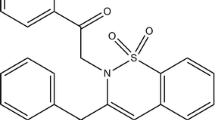Abstract
The metabolic fates of potassium canrenoate (PC) and spironolactone (SP) were compared for the rat in vivo and in vitro. Approximately 18% of an in vivo dose of SP was metabolized to canrenone (CAN) and related compounds in the rat. In vitro, 20–30% of SP was dethioacetylated to CAN and its metabolites by rat liver 9000 g supernatant (S9). Thus, the major route of SP metabolism is via pathways that retain the sulfur moiety in the molecule. PC was metabolized by rat hepatic S9 to 6α, 7α- and 6β, 7β-epoxy-CAN. The β-epoxide was further metabolized to its 3α- and 3β-hydroxy derivatives as well as its glutathione (GSH) conjugate. Both 3α- and 3β-hydroxy-6β, 7β-epoxy-CAN were shown to be direct acting mutagens in the mouse lymphoma assay, whereas 6α, 7α- and 6β, 7β-epoxy-CAN were not. These mutagenic metabolites, their precursor epoxides and their GSH conjugates were not formed from SP under identical conditions. The above findings appear to be due to inhibition of metabolism of CAN formed from SP by SP and/or its S-containing metabolites, since the in vitro metabolism of PC by rat hepatic microsomes was appreciably reduced in the presence of SP. The hypothesized mechanism(s) for this inhibition is that SP and its S-containing metabolites specifically inhibit an isozyme of hepatic cytochrome P-450 or SP is a preferred substrate over PC/CAN for the metabolizing enzymes. Absence of the CAN epoxide pathway in the metabolism of SP provides a possible explanation for the observed differences in the toxicological profiles of the two compounds.
Similar content being viewed by others
References
Abshagen U, Bensenfelder E, Endele R, Koch K, Neubert B (1979) Kinetics of canrenone after single and multiple doses of spironolactone. Eur J Clin Pharmacol 16: 225
Cifone M (1985) Mutagenicity evaluation of soldactone in the mouse lymphoma forward mutation assay. Litton Bionetics, Inc., for G. D. Searle & Co. PS 85C-2257A
Clive D, Spector JFS (1975) Laboratory procedures for assessing specific locus mutations at the TK locus in cultured L5178Y mouse lymphoma cells. Mutat Res 31: 17–29
Clive D, Johnson KO, Spector JFS, Batson AG, Brown MMM (1979) Validation and characterization of the L5178Y/TK+/− mouse lymphoma mutagen assay system. Mutat Res 59: 61–108
Clive D, McCuen R, Spector JFS, Piper C, Mavournin KH (1983) Specific gene mutations in L5178Y cells in culture; a report of the US Environmental Protection Agency Gene-Tox Program. Mutat Res 115: 225–251
Decker C, Sugyama K, Underwood M, Correia MA (1986) Inactivation of rat hepatic cytochrome P-450 by spironolactone. Biochem Biophys Res Commun 136: 1162–1169
Haykawa T, Udenfriend S, Yagi H, Jerina DM (1975) Substrates and inhibitors of hepatic glutathione-S-epoxide transferase. Arch Biochem Biophys 170: 438–451
Lowry OH, Rosebrough NJ, Farr AL, Randell RJ (1951) Protein measurement with the Folin phenol reagent. J Biol Chem 193: 265–275
Lumb G, Newberne P, Rust JH, Wagner B (1978) Effects in animals of chronic administration of spironolactone — a review. J Environ Pathol Toxicol 1: 641–660
Menard RH, Stripp B, Gillette JR (1974) Spironolactone and testicular cytochrome P-450: decreased testosterone formation in several species and changes in hepatic drug metabolism. Endocrinology 94 (6): 1628–1636
Menrad RH, Loriaux DL, Bartter FC, Gillette JR (1978) The effect of the administration of spironolactone on the concentration of plasma testosterone, estradiol and cortisol in male dogs. Steroids 31 (61): 771–782
Menrad RH, Guenther TM, Kon H, Gillette JR (1979) Studies on the destruction of adrenal and testicular cytochrome P-450 by spironolactone. J Biol Chem 254: 1726
Merkus FWHM (1983) Is Canrenone the major metabolite of spironolactone? Clin Pharm 2: 209–210
Merkus FWHM, Overdiek JWPM, Cilissen J, Juidema J (1983) Pharmacokinetics of spironolactone after a single dose: evaluation of the true canrenone serum concentrations during 24 hours. Clin Exp Hypertens 5: 239–24
Oesch F (1973) Mammalian epoxide hydrases: inducible enzymes catalyzing the inactivation of carcinogenic and cytotoxic metabolites derived from aromatic and olefinic compounds. Xenobiotica 3: 305–340
Overdiek HWPM, Merkus FWHM (1986) Influence of food on the bioavailability of spironolactone. Clin Pharmacol Ther 40: 531–536
Overdiek HWPM, Hermens WAAJ, Merkus FWHM (1985) New insights into the pharmacokinetics of spironolactone. Clin Pharmacol Ther 38: 469
Sadee W, Riegelman S, Jones SC (1972a) Disposition of tritium labelled spironolactone in the dog. J Pharm Sci 61: 1132
Sadee W, Riegelman S, Jones SC (1972b) Plasma levels of spironolactone in the dog. J Pharm Sci 61: 1129
Sadee W, Abshagen U, Finn C, Rietbrook N (1974) Conversion of spironolactone to canrenone and disposition kinetics of spironolactone and canrenoate-potassium in rats. Naunyn-Schmiedeberg's Arch Pharmacol 283: 303
Sammett D, Lee EW, Kocsis JJ, Snyder R (1979) Partial hepatectomy reduces both metabolism and toxicity of benzene. J Toxicol Environ Health 5: 785–792
Snyder R, Kocsis JJ (1975) Current concepts of chronic benzene toxicity. CRC Crit Rev Toxicol 3: 265–288
Tice RR, Costa DL, Drue RT (1980) Cytogenic effects of inhaled benzene in murine bone marrow: Induction of sister chromatid exchanges, chromosomal aberrations, and cellular proliferation inhibition in DBA/2 mice. Proc Natl Acad Sci USA 77: 2148–2152
Tunek A, Platt KL, Bentley P, Oesch F (1978) Microsomal metabolism of benzene to species irreversibly binding to microsomal protein and effects of modifications of this metabolism. Mol Pharmacol 14: 920–929
Author information
Authors and Affiliations
Rights and permissions
About this article
Cite this article
Cook, C.S., Hauswald, C.L., Schoenhard, G.L. et al. Difference in metabolic profile of potassium canrenoate and spironolactone in the rat: Mutagenic metabolites unique to potassium canrenoate. Arch Toxicol 61, 201–212 (1988). https://doi.org/10.1007/BF00316635
Received:
Accepted:
Issue Date:
DOI: https://doi.org/10.1007/BF00316635




